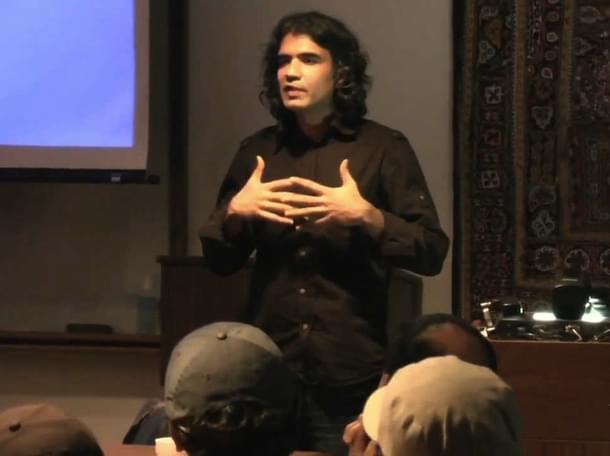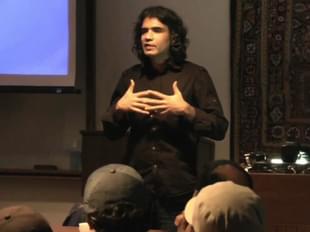Culture
Interview: The State Of Urdu
Antara Das
Feb 22, 2015, 08:45 PM | Updated Feb 11, 2016, 08:33 AM IST
Save & read from anywhere!
Bookmark stories for easy access on any device or the Swarajya app.


Antara Das interviews author and lyricist Mir Ali Husain
Mir Ali Husain is a professor of management at William Paterson University, USA and the co-author of Anthems of Resistance, a book on the history and politics of the Urdu poets of the Progressive Writers’ Movement. He occasionally writes lyrics and works on scripts for Bollywood cinema. At the ZEE Jaipur Literature Festival 2015, he talks to Antara Das about Urdu, the subject closest to his heart.
Q: You have an engineering and management background, and then there is your fondness for Urdu poetry. Was the former a compulsion, the latter a passion?
A: No, I don’t think so. Like many people of my generation I am probably the product of my parents’ middle-class entitlements. Growing up, in their understanding, one either became a doctor or an engineer or a failure!
As far as poetry is concerned, I grew up in an atmosphere where poetry was very much in the air. It’s a legacy of the country, of the cultural milieu I grew up in, where it was considered appropriate, at least in my parents’ generation, to use couplets to answer questions or narrate a story and thus to say ordinary things in extraordinary ways. In order to use the appropriate couplet, you had to know hundreds and hundreds of them and pluck the right one out from memory.
Q: It’s come down orally then.
A: Urdu poetry, certainly, is a very oral tradition. Most poets never publish their poems. If you go to Urdu bookstores, only a handful of very famous poets have their poems published. If you look at their publication run, it’s about 500 copies. Not many people read poetry. However, there are these mushairas — the performative aspect of Urdu poetry. I went to several when I was a child. If a particular couplet was really good, you demanded the poet repeat it several times. By the time he was done, you knew it. Much of the poetry I know has come down to me this way. The big mushaira in Hyderabad was, and still is, the Shankarji Mushaira. I remember when I was growing up, a large number of Urdu poets were Hindus and Sikhs who would recite their best verses, save them for that particular mushaira.
Q: We tend to forget that syncretic past of Urdu poetry, that Urdu poetry is not Islamic poetry.
A: No, not at all. It’s also important to remember that Urdu is very much an indigeneous language of India. In my opinion, Urdu and Hindi are the same language with two different scripts. Of course, in their extreme ends, Persianised Urdu and Sanskritised Hindi are mutually incomprehensible. But in the everyday speak of the country, it’s difficult to identify one or the other. The reason is fairly simple. Urdu borrows its grammar 100 percent from Hindi or versions of Hindi that were prevalent at that time, like khariboli.
If you take an Urdu dictionary and note down every single word, 75 percent of it is derived from Sanskrit or Prakrit. Twenty-five percent of the vocabulary is from other sources, as Urdu originated within the military camps, where there were people from multiple linguistic groups. Because its poetic tradition was so strong, it borrowed words particularly from Farsi which allowed it to express multiple things in poetic ways. Languages are never pure and it’s ridiculous to think of Urdu as pure. It’s a very khichdi language.
Q: What is the status of Urdu now? Is it languishing, is there a lack of interest?
One of the most unfortunate things to happen to Urdu after independence was that it became identified as the language of Pakistan, which itself was a travesty, because at the time of the formation of the nation state of Pakistan, only seven percent of its population spoke Urdu. It was the ruling elite which decided to impose this language on their people from the top. As a consequence, Urdu lost a certain kind of status within independent India. But I think that’s a minor tragedy because the language continues to thrive in various places: spoken language, popular culture, Hindi cinema, lyrics of film songs. And people very unselfconsciously use words that are ‘Urdu’, without identifying them as such. Many people in those days thought of the language that they spoke as Hindustani, a category eliminated after independence. After that, people didn’t have the choice to say that their mother tongue was Hindustani.

Q: Bollywood doesn’t use as much Urdu as it used to.
I think it’s fair to say that. But again, languages are living, breathing things. They evolve with their times. There’s no reason to lament the transformation of popular language, no need to feel sad that Urdu words of a particular kind are no longer being used in Hindi film songs. Songs should reflect the language that people speak today. If that language is changing, the language of songs will automatically change. Many great, classical languages have withered away. That’s the way of the world.
You can still find a certain kind of prettiness in expression of complicated thoughts. Urdu has this word called raqeeb, which can be loosely translated as being ‘rivals in love’, usually two men who are in love with the same woman. But that word is invested with much more meaning. You are antagonists in desiring the same thing, but there’s also a great amount of mutual respect because you realise that this person [the antagonist] has such good taste. The ability to say so much with such brevity, that must be valued, nurtured, cherished.
Below: A song written by Husain
https://www.youtube.com/watch?v=d8me1GXijJA
Antara Das is the Books and Culture Editor of Swarajya





